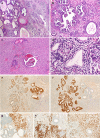Malignant teratoid tumor of the thyroid gland: an aggressive primitive multiphenotypic malignancy showing organotypical elements and frequent DICER1 alterations-is the term "thyroblastoma" more appropriate?
- PMID: 32507920
- PMCID: PMC7683491
- DOI: 10.1007/s00428-020-02853-1
Malignant teratoid tumor of the thyroid gland: an aggressive primitive multiphenotypic malignancy showing organotypical elements and frequent DICER1 alterations-is the term "thyroblastoma" more appropriate?
Abstract
Primary thyroid teratomas are exceedingly rare. Mature and immature variants recapitulate their gonadal counterparts (predilection for infants/children, triphasic germ layer differentiation, and favorable outcome). On the other hand, the so-called malignant teratomas affect predominantly adults and elderly, are highly aggressive, and, according to a few published cases, harbor DICER1 mutations. We describe three highly aggressive sporadic malignant teratoid thyroid tumors in 2 females (17 and 45 years) and one male (17 years). Histology showed triphasic neoplasms composed of solid nests of small primitive monomorphic cells embedded in a cellular stroma with primitive immature rhabdomyosarcoma-like (2) or pleomorphic sarcoma-like (1) phenotype. The third component was represented by TTF1+/PAX8+ primitive teratoid epithelial tubules reminiscent of primitive thyroid follicles and/or Wilms tumor, admixed with scattered respiratory- or enteric-type tubules, neuroepithelial rosettes, and fetal-type squamoid nests. Foci of cartilage were seen in two cases, but none contained mature organoid adult-type tissue or skin adnexa. SALL4 was expressed in the small cell (2) and stromal (1) component. Other germ cell markers were negative. Molecular testing revealed a known "hotspot" pathogenic DICER1 mutation in two cases. In addition, case 1 had a missense TP53 variant. This type of thyroid malignancy is distinct from genuine teratomas. The immunoprofile suggests primitive thyroid- or branchial cleft-like differentiation. Given that "blastoma" is a well-accepted terminology in the spectrum of DICER1-associated malignancies, the term "thyroblastoma" might be more convenient for these malignant teratoid tumors of the thyroid gland. Relationship of thyroblastoma to the DICER1 syndrome remains to be addressed.
Keywords: DICER1; Germ cell tumor; Head and neck; Malignant teratoma; Rhabdomyosarcoma; Teratocarcinosarcoma; Thyroblastoma; Thyroid.
Conflict of interest statement
The authors declare that they have no conflict of interest.
Figures



References
-
- Furtado LV, Thompson LDR. Germ cell tumours. In: Lloyd RV, Osamura RY, Klöppel G, Rosai J, editors. WHO classification of tumours of endocrine organs. 4. Lyon: IARC Press; 2017. pp. 139–141.
Publication types
MeSH terms
Substances
LinkOut - more resources
Full Text Sources
Medical
Research Materials
Miscellaneous

